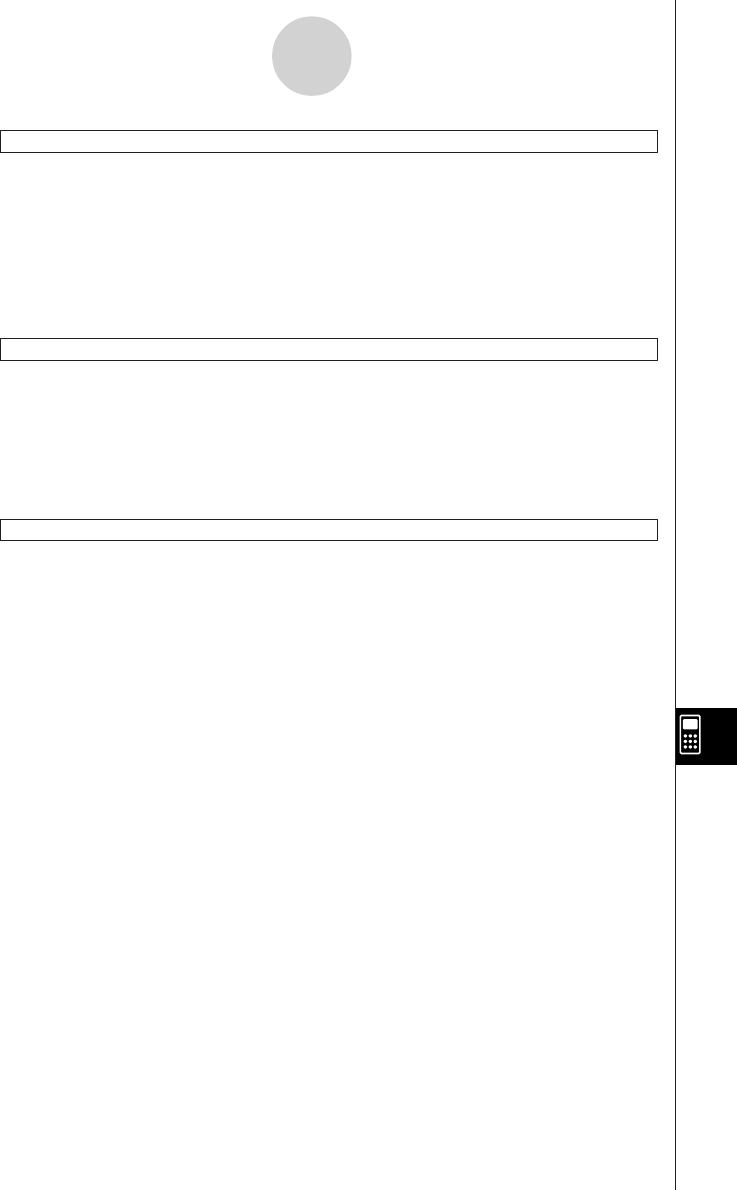User Manual
Table Of Contents
- Getting Ready
- Contents
- About This User’s Guide
- Chapter 1 Getting Acquainted
- Chapter 2 Using the Main Application
- 2-1 Main Application Overview
- 2-2 Basic Calculations
- 2-3 Using the Calculation History
- 2-4 Function Calculations
- 2-5 List Calculations
- 2-6 Matrix and Vector Calculations
- 2-7 Using the Action Menu
- 2-8 Using the Interactive Menu
- 2-9 Using the Main Application in Combination with Other Applications
- 2-10 Using Verify
- Chapter 3 Using the Graph & Table Application
- Chapter 4 Using the Conics Application
- Chapter 5 Using the 3D Graph Application
- Chapter 6 Using the Sequence Application
- Chapter 7 Using the Statistics Application
- 7-1 Statistics Application Overview
- 7-2 Using List Editor
- 7-3 Before Trying to Draw a Statistical Graph
- 7-4 Graphing Single-Variable Statistical Data
- 7-5 Graphing Paired-Variable Statistical Data
- 7-6 Using the Statistical Graph Window Toolbar
- 7-7 Performing Statistical Calculations
- 7-8 Test, Confidence Interval, and Distribution Calculations
- 7-9 Tests
- 7-10 Confidence Intervals
- 7-11 Distribution
- 7-12 Statistical System Variables
- Chapter 8 Using the Geometry Application
- Chapter 9 Using the Numeric Solver Application
- Chapter 10 Using the eActivity Application
- Chapter 11 Using the Presentation Application
- Chapter 12 Using the Program Application
- Chapter 13 Using the Spreadsheet Application
- Chapter 14 Using the Setup Menu
- Chapter 15 Configuring System Settings
- 15-1 System Setting Overview
- 15-2 Managing Memory Usage
- 15-3 Using the Reset Dialog Box
- 15-4 Initializing Your ClassPad
- 15-5 Adjusting Display Contrast
- 15-6 Configuring Power Properties
- 15-7 Specifying the Display Language
- 15-8 Specifying the Font Set
- 15-9 Specifying the Alphabetic Keyboard Arrangement
- 15-10 Optimizing “Flash ROM”
- 15-11 Specifying the Ending Screen Image
- 15-12 Adjusting Touch Panel Alignment
- 15-13 Viewing Version Information
- Chapter 16 Performing Data Communication
- Appendix

20050501
12-6-9
Program Command Reference
Break
Syntax: Break
Function: This command terminates a loop and causes execution to advance to the next
command following the loop process.
Description
• Break terminates a loop and causes execution to advance to the next command following
the loop process.
• Break can be used inside of a For, Do, While, or Switch process.
Define
Syntax: Define
䡺
[<folder name>\ ]<function name>([<variable name>[,<variable
name>...]]) =<expression>
• Items inside of brackets ([ ]) can be skipped.
Function: Creates a user-defined function.
Description: See page 12-5-2.
Do~LpWhile
Syntax: Do
[<statement>] …
LpWhile
䡺
<expression>
<expression> is a condition that evaluates to true or false.
Function: The specified statements are repeated as long as the condition is true.
Description
• The statements between Do~LpWhile are repeated as long as the condition is true. When
the condition becomes false, execution jumps to the next command after the LpWhile
command.
•Since the condition comes after LpWhile, the condition is not evaluated until the end of the
loop is reached.
•You can use a multi-statement command (:) in place of the carriage return to separate
statements.
• It is always a bad idea to use the Goto command to exit a Do~LpWhile loop. Not only is it
poor programming, it can cause problems due to improper termination of internal
processes used by the loop operation.










